▼音声で学びたい方はこちらへ🐻
現在撮影中
▼ELEMENT2-高2《Lesson1》はこちらから🐻
- 授業前にひとこと
- 勉強のポイント
- 本文&和訳
- 重要単語
- 重要ポイント
- 【1】Imagine a couple who has been together for 50 years.
- 【2】Then, imagine another who has known each other for only a month.
- 【3】Would there be any difference in their communication style?
- 【4】You may say that conversation between the long-term couple would be quieter compared to those who have just met.
- 【5】The new couple may talk a lot about what they want to share with each other.
- 【6】The long-term couple may be compared to Japanese, who have shared the same culture for thousands of years.
- 【7】On the other hand, the couple who have recently got together may have a communication style similar to that of most Americans.
- 【8】In Japan, people learn to “read the air” to understand the intentions of others from childhood.
- 【9】This is called “high-context communication” because Japanese rely on the context in order to understand the true message when communicating.
- 【10】On the other hand, the American way is called “low-context communication.”
- 【11】In such a culture, which is made up of immigrants who share only a few hundred years of history, people learn to speak as clearly as possible, with little use of context for understanding.
授業前にひとこと
今回は、ELEMENT2-高2《Lesson1》について扱っていきます❗️
Lesson1のタイトルは…🐻
Cultures around the World
という「文化の違いについてカルチャーマップを元に理解する」お話です。
ちなみに、このLessonでメインで使われている文法事項は…
形式目的語のit / 対応する能動態を持たない受動文
です❗️
ちなみに、この記事では…
ELEMENT
の本文を引用しています。
すでに上記の教科書をお持ちの方向けの記事になりますので、お持ちでない方は全国の『教科書取扱書店』にて購入してから、記事を読み進めるようにお願いします!
さて、いつも授業前に説明することですが…
⇧に載せてあります『単語・和訳・英作文トレーニング』をテスト1週間前から毎日やってみてください❗️曖昧な理解がなくなり、成績が爆伸びします!!
コミュ英以外の定期テスト対策は?
現代文の定期テスト対策は こちら から
古文の定期テスト対策は こちら から
漢文の定期テスト対策は こちら から


個別指導塾 SECOND《定期テストコース》 をもっと活用する


公式LINEアカウント では…
▷ 解説記事のリクエスト
▷ 新着情報のキャッチ
▷ 定期テスト予想問題
▷ オリジナルグッズの購入
ができるようになっています🐻
個別指導塾 SECOND《定期テストコース》 の 公式LINEアカウント はこちら
勉強のポイント
①本文は『日本とアメリカのコミュニケーションの違いについて』説明しているシーンであることを理解する。
②単語・重要ポイントをインプットする。
③形式目的語のit / 対応する能動態を持たない受動文 について理解する。
本文&和訳
本文(Scene1)
【1】Imagine a couple who has been together for 50 years.
50年間一緒に暮らしてきたカップルを想像してみてください。
Then, imagine another who has known each other for only a month.
そして、知り合ってまだ1ヶ月しか経っていないカップルを想像してみてください。
Would there be any difference in their communication style?
彼らのコミュニケーションスタイルには何か違いがあるでしょうか?
You may say that conversation between the long-term couple would be quieter compared to those who have just met.
長年連れ添ったカップルの会話は、出会ったばかりのカップルに比べて静かだと言えるかもしれません。
The new couple may talk a lot about what they want to share with each other.
新しいカップルは、お互いに共有したいことについてたくさん話すかもしれません。
The long-term couple may be compared to Japanese, who have shared the same culture for thousands of years.
長年連れ添ったカップルは、何千年も同じ文化を共有してきた日本人に似ているかもしれません。
On the other hand, the couple who have recently got together may have a communication style similar to that of most Americans.
一方、最近付き合い始めたカップルのコミュニケーションスタイルは、多くのアメリカ人と似ているかもしれません。
In Japan, people learn to “read the air” to understand the intentions of others from childhood.
日本では、幼い頃から相手の意図を理解するために「空気を読む」ことを学びます。
This is called “high-context communication” because Japanese rely on the context in order to understand the true message when communicating.
これは「ハイコンテクストコミュニケーション」と呼ばれています。なぜなら、日本人はコミュニケーションにおいて真のメッセージを理解するため、文脈に頼るからです。
On the other hand, the American way is called “low-context communication.”
一方、アメリカ人のコミュニケーションスタイルは「ローコンテクストコミュニケーション」と呼ばれています。
In such a culture, which is made up of immigrants who share only a few hundred years of history, people learn to speak as clearly as possible, with little use of context for understanding.
わずか数百年の歴史しか共有していない移民によって構成されるこのような文化では、人々は理解のために文脈をほとんど考慮せずに、できるだけ明確に話すことを学びます。
重要単語


単語にはさまざまな意味がありますが、まずは定期テストを乗り越えるために、文章中で使われている意味で紹介しています🐻
V : 動詞 , Ving : 動名詞 , Vpp : 過去分詞, O:目的語, C:補語
| 英単語 / 熟語 | 品詞 | 意味(和訳) |
| imagine | 動詞 | 想像する |
| couple | 名詞 | カップル、夫婦 |
| together | 副詞 | 一緒に |
| difference | 名詞 | 違い、差異 |
| communication | 名詞 | コミュニケーション、意思疎通 |
| style | 名詞 | 様式、スタイル |
| conversation | 名詞 | 会話 |
| compared to A | 熟語 | Aと比べて |
| recently | 副詞 | 最近 |
| similar to A | 熟語 | Aに似ている |
| culture | 名詞 | 文化 |
| childhood | 名詞 | 子供時代、幼少期 |
| intention | 名詞 | 意図、意志 |
| context | 名詞 | 文脈、状況、背景 |
| message | 名詞 | メッセージ、伝えたい内容 |
| immigrant | 名詞 | 移民 |
| clearly | 副詞 | 明確に、はっきりと |
| understanding | 名詞 | 理解 |
| rely on A | 熟語 | Aに頼る |
| high-context communication | 名詞句 | ハイコンテクスト・コミュニケーション(文脈依存型) |
| low-context communication | 名詞句 | ローコンテクスト・コミュニケーション(明示型) |
| speak as ~ as possible | 熟語 | 出来るだけ〜に話す |
重要ポイント


「ピンク」=重要ポイント
▼記号について
V : 動詞 Ving : 動名詞 Vpp : 過去分詞
【 】名詞句・節 〈 〉形容詞句・節 ( )副詞句・節
S:主語 O:目的語 C:補語 M:副詞
【1】Imagine a couple who has been together for 50 years.
《和訳》
50年間一緒に暮らしてきたカップルを想像してみてください。
《重要ポイント》


この文では…
・命令文
・関係代名詞
・現在完了
・時間表現
が学べます!
受験に向けてもしっかり学ぼう🐻
「Imagine a couple」= カップルを想像してみてください
命令文(”Imagine ~”)
・主語がないので、命令文だと分かる。
・「〜を想像してごらん」という意味。
不定冠詞 “a”
・ “a couple” は「ある一組のカップル」という意味。
・特定されていない単数名詞に使われる不定冠詞。
「a couple who has been together for 50 years」= 50年間一緒に暮らしてきたカップル
関係代名詞 “who”
・”couple”(人)を先行詞とした関係代名詞 “who”
・関係詞については下の画像で復習。
・couple を後ろから説明している。
現在完了形 “has been”
・”has been together” は「ずっと一緒にいる」という状態の継続を表す現在完了形。
・ここでは「50年間ずっと一緒にいる」と長い継続を強調。
・現在完了のイメージについても下の画像で復習しましょう。
時間表現 “for 50 years” の用法
・”for + 期間” の形で「〜の間ずっと」を表す。
・現在完了形と非常に相性のよい表現で、継続のニュアンスを明確にする。
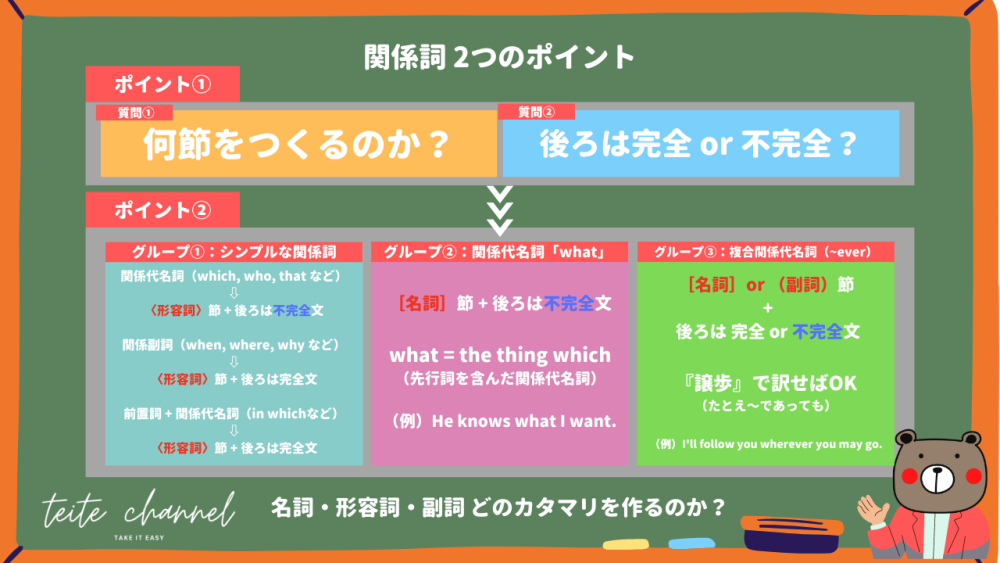



ここまで執筆完了❗️リクエストがあれば解説を加えていきます!


すぐに解説記事を見たい方は、こちらのLINEからリクエストを送ってくださいね🐻
個別指導塾 SECOND《定期テストコース》 の 公式LINEアカウント はこちら
【2】Then, imagine another who has known each other for only a month.
《和訳》
そして、知り合ってまだ1ヶ月しか経っていないカップルを想像してみてください。
《重要ポイント》
【3】Would there be any difference in their communication style?
《和訳》
彼らのコミュニケーションスタイルには何か違いがあるでしょうか?
《重要ポイント》
【4】You may say that conversation between the long-term couple would be quieter compared to those who have just met.
《和訳》
長年連れ添ったカップルの会話は、出会ったばかりのカップルに比べて静かだと言えるかもしれません。
《重要ポイント》
【5】The new couple may talk a lot about what they want to share with each other.
《和訳》
新しいカップルは、お互いに共有したいことについてたくさん話すかもしれません。
《重要ポイント》
【6】The long-term couple may be compared to Japanese, who have shared the same culture for thousands of years.
《和訳》
長年連れ添ったカップルは、何千年も同じ文化を共有してきた日本人に似ているかもしれません。
《重要ポイント》
【7】On the other hand, the couple who have recently got together may have a communication style similar to that of most Americans.
《和訳》
一方、最近付き合い始めたカップルのコミュニケーションスタイルは、多くのアメリカ人と似ているかもしれません。
《重要ポイント》
【8】In Japan, people learn to “read the air” to understand the intentions of others from childhood.
《和訳》
日本では、幼い頃から相手の意図を理解するために「空気を読む」ことを学びます。
《重要ポイント》
【9】This is called “high-context communication” because Japanese rely on the context in order to understand the true message when communicating.
《和訳》
これは「ハイコンテクストコミュニケーション」と呼ばれています。なぜなら、日本人はコミュニケーションにおいて真のメッセージを理解するため、文脈に頼るからです。
《重要ポイント》
【10】On the other hand, the American way is called “low-context communication.”
《和訳》
一方、アメリカ人のコミュニケーションスタイルは「ローコンテクストコミュニケーション」と呼ばれています。
《重要ポイント》
【11】In such a culture, which is made up of immigrants who share only a few hundred years of history, people learn to speak as clearly as possible, with little use of context for understanding.
《和訳》
わずか数百年の歴史しか共有していない移民によって構成されるこのような文化では、人々は理解のために文脈をほとんど考慮せずに、できるだけ明確に話すことを学びます。
《重要ポイント》


これで全て終了です❗️
「ELEMENT2-高2《Lesson1-1 | Cultures around the World(The Culture Map)」おつかれさまでした🐻
形式目的語のit / 対応する能動態を持たない受動文 を踏まえて読解すれば、比較的話しの流れは掴みやすいですが、それが出来ていないと苦戦している文章もあったのではないでしょうか❗️
理解出来ている人も、油断せずに復習&音読するのをお忘れなく!!
①授業前にひとこと、でも話しましたが…
⇧に載せてあります『単語・和訳・英作文トレーニング』をテスト1週間前から毎日やってみてください❗️曖昧な理解がなくなり、成績が爆伸びします!!
最後まで見てくださってありがとうございました!
またお会いしましょう!定期テストがんばれ〜🐻
じゃあね〜、バイバイ!!
-》-トレーニング』-485x273.png)
-》-トレーニング』-485x273.png)
-》-トレーニング』-485x273.png)






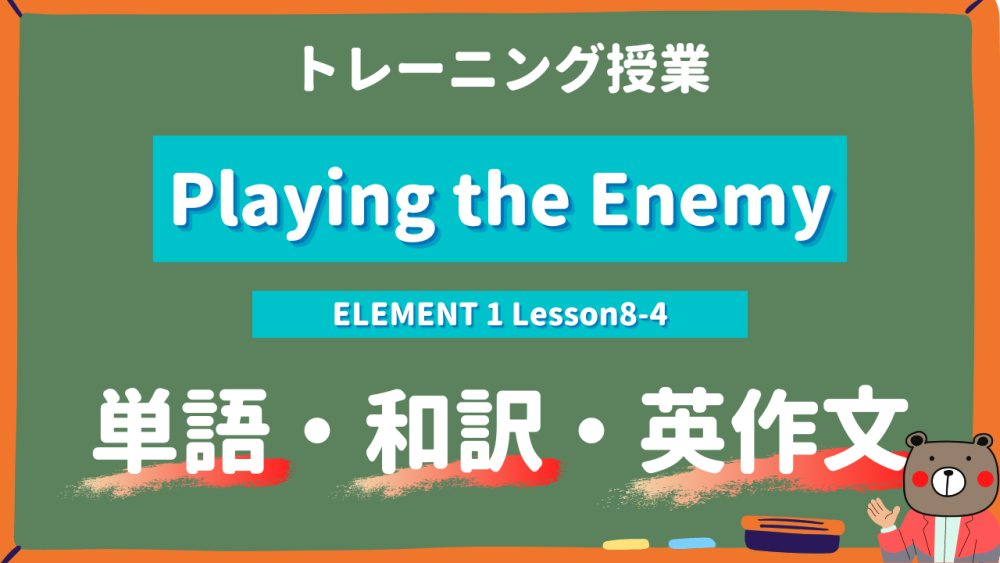
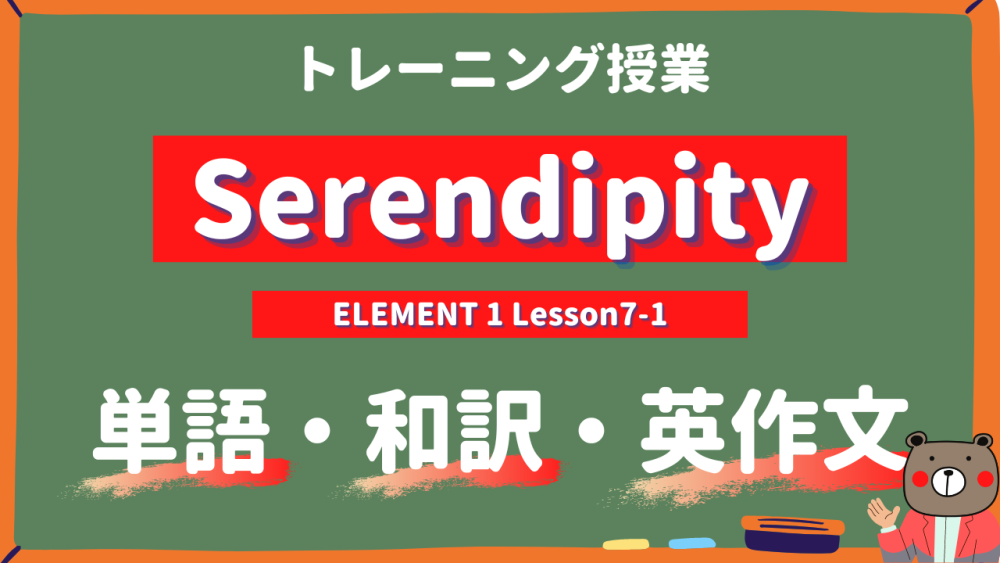


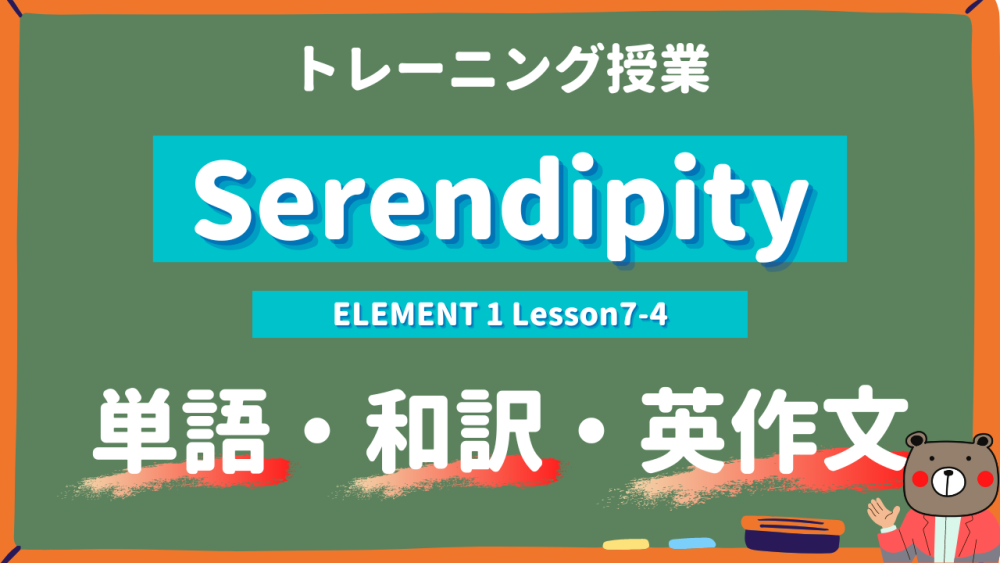
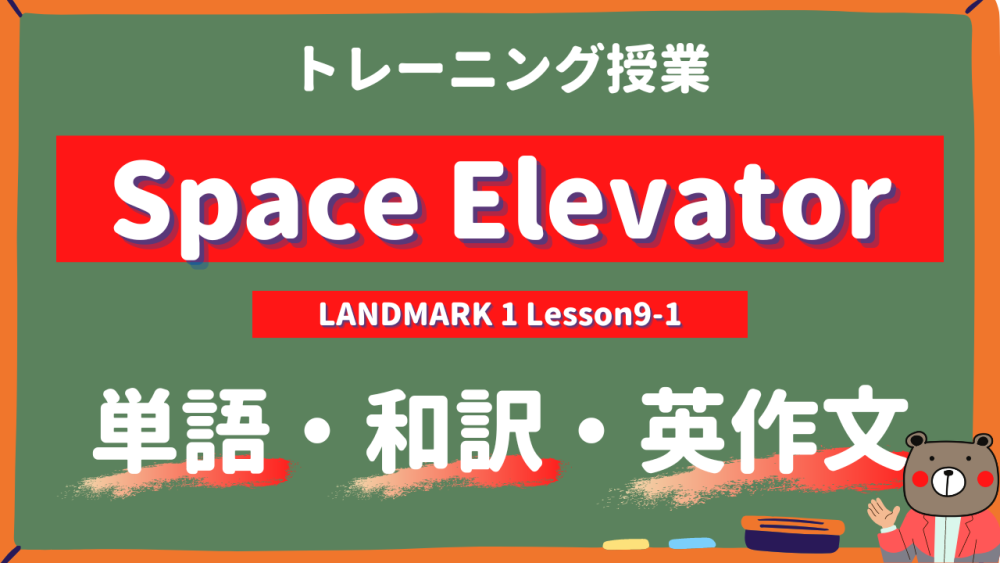

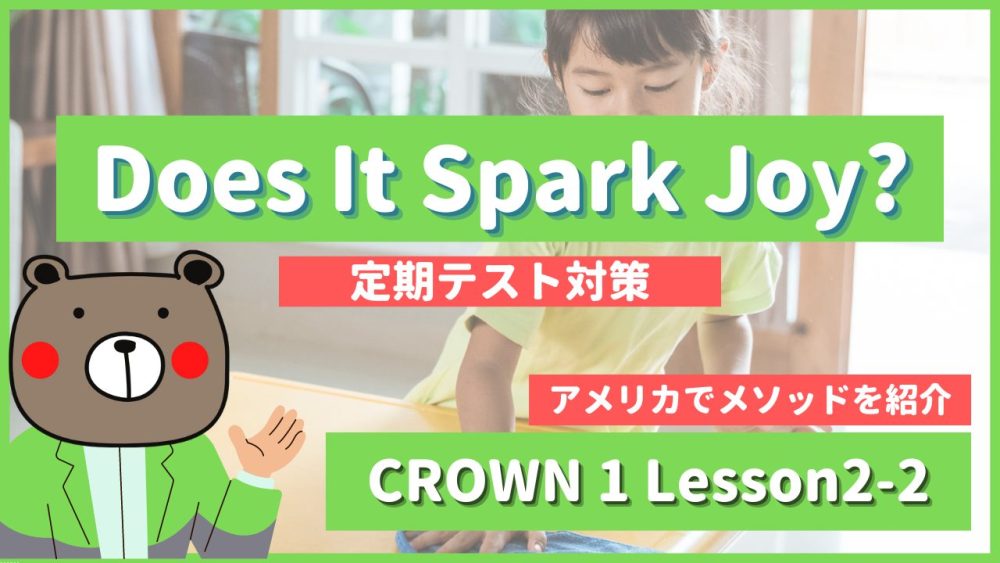
おすすめ勉強法は、テキストを見ながら、こちらの音声で学ぶと、目(視覚)も耳(聴覚)も両方使えるので、効果バツグンです🐻